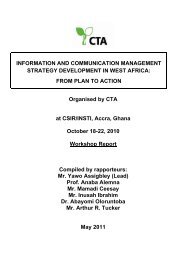Download Workshop Report [PDF] - ICM strategy development - CTA
Download Workshop Report [PDF] - ICM strategy development - CTA
Download Workshop Report [PDF] - ICM strategy development - CTA
Create successful ePaper yourself
Turn your PDF publications into a flip-book with our unique Google optimized e-Paper software.
• Negating threats?<br />
• Does it fit with information audits?<br />
Selecting options<br />
Selecting options is about risk:<br />
• Organisation: the new <strong>strategy</strong> may affect management and operational staff.<br />
• Political – challenges to government policy encroaching on an organisation’s area of<br />
interest or mandate.<br />
• Financial implication – is it affordable?<br />
• Technical – need new ICTs? Can they be supported? Are they suitable?<br />
8. The <strong>ICM</strong> Strategy Development Process<br />
8.1 Issue 9 - The <strong>ICM</strong> Strategy Development (“ABC”) Process – Mr. Peter Walton<br />
The discussion highlighted the following:<br />
• A = Alliance - <strong>ICM</strong> <strong>development</strong> process involves alliance which brings up the issue<br />
of trust and mutuality. It must be absolutely clear what alliance is, its purpose,<br />
commitment and obligations. The alliance must be formalised or there can be other<br />
written instruments, for an example a code of conduct, to guide an informal alliance.<br />
• It was deliberated that informal agreements can be problematic. Another concern<br />
regarding alliances is the matter of ownership (of the data, information, products,<br />
etc), which can impact relationships. In some instances ownership maybe shared but<br />
it must be an equitable relationship. This must be clearly stipulated in the formal<br />
agreement. When forming an alliance it is clear that some organisations carry a<br />
greater burden of responsibility.<br />
• B = Bargain - Management and financial issues must be very clear in any formal<br />
agreement. People are making their time available for joint action therefore it must<br />
clearly indicated who does what. Bargains have the advantage of combining the<br />
resources of organisations and variations of skills and capacity could be a benefit to<br />
the programme. Organisations bring funding to the alliance or they may access donor<br />
funding as a group.<br />
• C = Compromise – any agreements involve compromise of one form or another.<br />
The parties involved have to agree on a set of standards in order to achieve common<br />
goals. The extent of money and management contribution must be clear. In the<br />
agreement one partner may have a greater financial and management burden, and<br />
as a result one partner may lose flexibility and the freedom to act independently.<br />
• The issue of selling and marketing of <strong>strategy</strong> was highlighted. People that are<br />
enthusiastic about the <strong>strategy</strong> can be used as champions to sell the <strong>strategy</strong>. It is<br />
important to clearly communicate the <strong>strategy</strong> to all affected parties to reduce the<br />
fear of uncertainty induced by change and ensure participation - “the <strong>strategy</strong> is<br />
political statement”. A <strong>strategy</strong> document can succeed as political statement but fail<br />
as a plan (e.g. in Iran) or it can succeed as planning document but fail as political<br />
statement (e.g. India).<br />
15 | P age


![Download Workshop Report [PDF] - ICM strategy development - CTA](https://img.yumpu.com/5365638/15/500x640/download-workshop-report-pdf-icm-strategy-development-cta.jpg)
